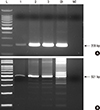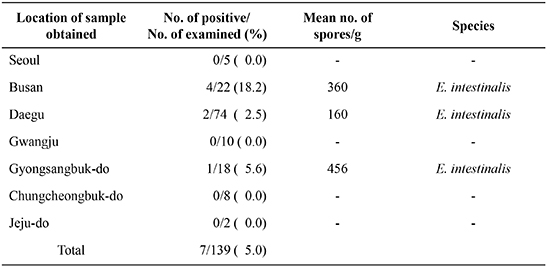1. Didier ES. Microsporidiosis: an emerging and opportunistic infection in humans and animals. Acta Trop. 2005; 94:61–76.
2. Mathis A, Tanner I, Weber R, Deplazes P. Genetic and phenotypic intraspecific variation in the microsporidian Encephalitozoon hellem. Int J Parasitol. 1999; 29:767–770.
3. Didier ES, Weiss LM. Microsporidiosis: current status. Curr Opin Infect Dis. 2006; 19:485–492.
4. Franzen C, Müller A. Microsporidiosis: human diseases and diagnosis. Microbes Infect. 2001; 3:389–400.
5. Ghosh K, Weiss LM. Molecular diagnostic tests for microsporidia. Interdiscip Perspect Infect Dis. 2009; 2009:926521.
6. Didier ES, Stovall ME, Green LC, Brindley PJ, Sestak K, Didier PJ. Epidemiology of microsporidiosis: sources and modes of transmission. Vet Parasitol. 2004; 126:145–166.
7. Dowd SE, Gerba CP, Pepper IL. Confirmation of the human-pathogenic microsporidia Enterocytozoon bieneusi, Encephalitozoon intestinalis, and Vittaforma corneae in water. Appl Environ Microbiol. 1998; 64:3332–3335.
8. Lee SY, Lee SS, Lyoo YS, Park HM. DNA detection and genotypic identification of potentially human-pathogenic microsporidia from asymptomatic pet parrots in South Korea as a risk factor for zoonotic emergence. Appl Environ Microbiol. 2011; 77:8442–8444.
9. Jeong DK, Won GY, Park BK, Hur J, You JY, Kang SJ, Oh IG, Lee YS, Stein BD, Lee JH. Occurrence and genotypic characteristics of Enterocytozoon bieneusi in pigs with diarrhea. Parasitol Res. 2007; 102:123–128.
10. Lee JH. Prevalence and molecular characteristics of Enterocytozoon bieneusi in cattle in Korea. Parasitol Res. 2007; 101:391–396.
11. Hong S, Kim K, Yoon S, Park W-Y, Sim S, Yu J-R. Detection of Cryptosporidium parvum in Environmental Soil and Vegetables. J Korean Med Sci. 2014; 29:1367–1371.
12. Lee SU, Joung M, Ahn MH, Huh S, Song H, Park WY, Yu JR. CP2 gene as a useful viability marker for Cryptosporidium parvum. Parasitol Res. 2008; 102:381–387.
13. Hollister WS, Canning EU, Anderson CL. Identification of Microsporidia causing human disease. J Eukaryot Microbiol. 1996; 43:104s–105s.
14. Xiao L, Li L, Moura H, Sulaiman I, Lal AA, Gatti S, Scaglia M, Didier ES, Visvesvara GS. Genotyping Encephalitozoon hellem isolates by analysis of the polar tube protein gene. J Clin Microbiol. 2001; 39:2191–2196.
15. Haro M, Del Aguila C, Fenoy S, Henriques-Gil N. Intraspecies genotype variability of the microsporidian parasite Encephalitozoon hellem. J Clin Microbiol. 2003; 41:4166–4171.
16. Kotler DP, Orenstein JM. Clinical syndromes associated with microsporidiosis. Adv Parasitol. 1998; 40:321–349.
17. Weber R, Deplazes P, Schwartz D. Diagnosis and clinical aspects of human microsporidiosis. Contrib Microbiol. 2000; 6:166–192.
18. Wittner M, Weiss L. Epidemiology of microspridiosis. In : Bryan RT, Schwartz DA, editors. Epidemiology of microspridiosis. Washington, DC: American Society of Microbiology;1999. p. 502–516.
19. Deplazes P, Mathis A, Weber R. Epidemiology and zoonotic aspects of microsporidia of mammals and birds. Contrib Microbiol. 2000; 6:236–260.
20. Yakoob J, Abbas Z, Beg MA, Jafri W, Naz S, Khalid A, Khan R. Microsporidial infections due to Encephalitozoon intestinalis in non-HIV-infected patients with chronic diarrhoea. Epidemiol Infect. 2012; 140:1773–1779.
21. Friedberg DN, Stenson SM, Orenstein JM, Tierno PM, Charles NC. Microsporidial keratoconjunctivitis in acquired immunodeficiency syndrome. Arch Ophthalmol. 1990; 108:504–508.
22. Liguory O, Fournier S, Sarfati C, Derouin F, Molina JM. Genetic homology among thirteen Encephalitozoon intestinalis isolates obtained from human immunodeficiency virus-infected patients with intestinal microsporidiosis. J Clin Microbiol. 2000; 38:2389–2391.











 PDF
PDF ePub
ePub Citation
Citation Print
Print




 XML Download
XML Download